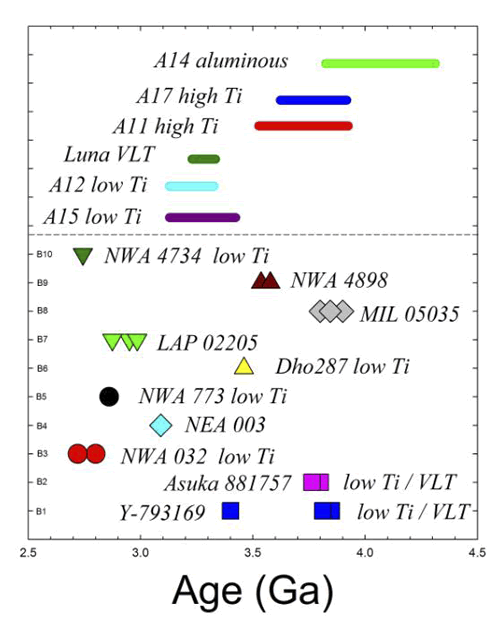Lunar Meteorite Contribution to Lunar Science
Lunar meteorites have provided a wealth of new information, requiring revision to some specific scenarios arising out of studies of the Apollo sample collection.
- 1) Age of basaltic volcanism
Evolved and young low Ti basalts provide evidence that the Moon maintained widespread active magmatism up to ~2.9 Ga (Fig. 8); (Fagan et al., 2002; Nyquist et al., 2005; Borg et al., 2004; Rankenburg et al., 2005). Some of the basaltic rocks are highly fractionated and have the lowest MgO contents of corresponding basalt suites among the 13 Apollo samples (Righter et al., 2005; Anand et al., 2005; Zeigler et al., 2005; Joy et al., 2005). In addition, low Ti basaltic meteorites, Asuka 881757, Yamato793169, MIL 05035 and MET 01210 have yielded the oldest ages for basalt of this composition – 3.8 to 3.9 Ga (Fig. 8; Arai et al., 2008). Basilevsky et al. (2009) emphasize that the gaps in the ages of Apollo basalt groups disappear when the ages of meteoritic basalts are included is assessments.
- 2) Crustal evolution
Studies of feldspathic lunar meteorites have revealed a rich compositional and petrologic diversity that is inconsistent with a simple picture of a flotation crust of ferroan anorthosite (Korotev et al., 2003). A) The Apollo high magnesium suite of plutonic rocks has not been identified in lunar meteorites, suggesting that this suite is of local, rather than global importance. B) On the other hand feldspathic clasts from highlands breccias yield Sr and Nd isochrons of 4.4 Ga (Fig. 9), providing evidence for an ancient LMO (Nyquist et al., 2002). Clasts in Y-86032 and MAC 88105 are among oldest and also record evidence for magma ocean and differentiation (not just an artifact of Apollo sampling bias). C) a fourth mafic crustal end member is present in highlands breccias (Korotev et al., 2009b).
- 3) late heavy bombardment – cataclysm or period of decline?
Impact melt clasts from meteoritic breccias have yielded ages that do not confirm or disprove the lunar cataclysm hypothesis, pushing the resolution of this controversial topic to analysis of new lunar meteorites or future sample return missions (Cohen et al., 2000). New high-resolution dating techniques have led to impact ages different from the cataclysmic spike at 3.85 Ga (Gnos et al., 2004). Evidence for the Lunar Cataclysm remains equivocal but many new highlands breccias (Table 1) will help resolve this important problem.
- 4) Global significance of Apollo defined units
KREEP has been recognized as an important component in only a few lunar meteorites (Korotev, 2005). The idea that KREEP existed only in the early Moon (3.8 to 4.6 Ga) has been challenged by evidence from a new lunar gabbro with a 2.9 Ga age and KREEP connections (Borg et al., 2004). High TiO2 basalt is part of bi-modal Apollo basaltic volcanism, but has only rarely been observed in a handful of meteorite samples.
In summary, lunar meteorites have so far provided new information that has led to a better understanding of fundamental issues such as the age, evolution, bulk composition and origin of the Moon. It is clear that Apollo-based models for lunar differentiation and magmatism must be revisited. Limited Apollo sample datasets, on which global models have been based, are of a more localized nature, and have likely led to erroneous models that cannot explain more global features observed in the meteorite and spacecraft datasets.

Figure 8: Compilation of ages for basaltic lunar meteorite, with chapter number (B#) along left edge of figure. References are B1 (Yamato 793169): Misawa et al. (1991); Fernandes et al. (2009); B2 (Asuka 881757): Kita-Torigoye et al. (1993); Fernandes et al. (2009); B3 (NWA032/479): Fagan et al. (2002); Borg et al. (2009); Fernandes et al. (2009); B4 (NEA 003): Haloda et al. (2009); B5 (NWA 773 and pairs): Borg et al. (2004); B6 (Dhofar 287): Shih et al. (2002); B7 (LAP 02205 and pairs): Rankenburg et al. (2005); Nyquist et al. (2005); Fernandes et al. (2009); B8 (MIL 05035): Nyquist et al. (2007); Fernandes et al. (2009); B9 (NWA 4898): Fernandes et al. (2009b), Gaffney et al. (2008); B10 (NWA 4734) Fernandes et al. (2009b).

Figure 9: Comparison of ages obtained from anorthositic and troctolitic clasts from feldspathic lunar meteorites: Yamato 86032 is from Nyquist et al. (2006) and Dhofar 489 data is from Takeda et al. (2006). Apollo FAN and Mg suite samples are from the compilation of Snyder et al. (2000) and Norman et al. (2003)
